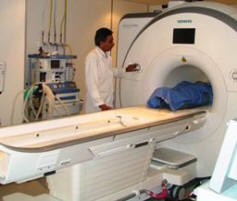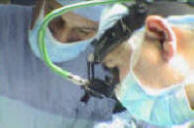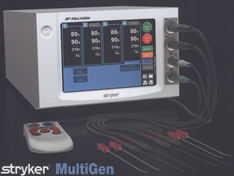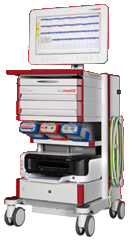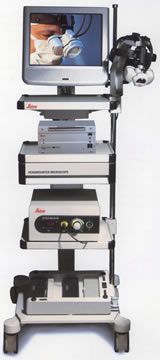|
PAIN
Pain is a
distressing feeling often caused by intense or damaging stimuli,
such as stubbing a toe, burning a finger, putting alcohol on a cut,
and bumping the "funny bone". Because it is a complex, subjective
phenomenon, defining pain has been a challenge. The International
Association for the Study of Pain's widely used definition states:
"Pain is an unpleasant sensory and emotional experience associated
with actual or potential tissue damage, or described in terms of
such damage. In medical diagnosis, pain is a symptom.
Pain motivates the individual to withdraw from damaging situations,
to protect a damaged body part while it heals, and to avoid similar
experiences in the future. Most pain resolves once the noxious
stimulus is removed and the body has healed, but it may persist
despite removal of the stimulus and apparent healing of the body.
Sometimes pain arises in the absence of any detectable stimulus,
damage or disease. Simple pain medications are useful in 20% to 70%
of cases.
Pain is the most common reason for physician consultation in most
developed countries. It is a major symptom in many medical
conditions, and can interfere with a person's quality of life and
general functioning. Psychological factors such as social
support, hypnotic suggestion, excitement, or distraction can
significantly affect pain's intensity or unpleasantness. In
some arguments put forth in physician-assisted suicide or euthanasia
debates, pain has been used as an argument to permit terminally ill
patients to end their lives.
Classification
In 1994, responding to the need for a more useful system for describing
chronic pain, the International Association for the Study of Pain (IASP)
classified pain according to specific characteristics: (1) region of the
body involved (e.g. abdomen, lower limbs), (2) system whose dysfunction
may be causing the pain (e.g., nervous, gastrointestinal), (3) duration
and pattern of occurrence, (4) intensity and time since onset, and (5)
etiology. However, this system has been criticized by Clifford J.
Woolf and others as inadequate for guiding research and treatment. Woolf
suggests three classes of pain : (1) nociceptive pain, (2) inflammatory
pain which is associated with tissue damage and the infiltration of
immune cells, and (3) pathological pain which is a disease state caused
by damage to the nervous system or by its abnormal function (e.g.
fibromyalgia, irritable bowel syndrome, tension type headache, etc.).
Duration
Acute, subacute and chronic pain
Pain is usually transitory, lasting only until the noxious stimulus is
removed or the underlying damage or pathology has healed, but some
painful conditions, such as rheumatoid arthritis, peripheral neuropathy,
cancer and idiopathic pain, may persist for years. Pain that lasts a
long time is called chronic or persistent, and pain that resolves
quickly is called acute. Traditionally, the distinction between acute
and chronic pain has relied upon an arbitrary interval of time from
onset; the two most commonly used markers being 3 months and 6 months
since the onset of pain, though some theorists and researchers have
placed the transition from acute to chronic pain at 12 months.
Others apply acute to pain that lasts less than 30 days, chronic to pain
of more than six months' duration, and subacute to pain that lasts from
one to six months. A popular alternative definition of chronic pain,
involving no arbitrarily fixed durations, is "pain that extends beyond
the expected period of healing". Chronic pain may be classified as
cancer pain or else as benign.
Nociceptive pain
Nociceptive pain is caused by stimulation of peripheral nerve fibers
that respond only to stimuli approaching or exceeding harmful intensity
(nociceptors), and may be classified according to the mode of noxious
stimulation. The most common categories are "thermal" (e.g. heat or
cold), "mechanical" (e.g. crushing, tearing, shearing, etc.) and
"chemical" (e.g. iodine in a cut or chemicals released during
inflammation).
Nociceptive pain may also be divided into "visceral", "deep somatic" and
"superficial somatic" pain. Visceral structures are highly sensitive to
stretch, ischemia and inflammation, but relatively insensitive to other
stimuli that normally evoke pain in other structures, such as burning
and cutting. Visceral pain is diffuse, difficult to locate and often
referred to a distant, usually superficial, structure. It may be
accompanied by nausea and vomiting and may be described as sickening,
deep, squeezing, and dull. Deep somatic pain is initiated by stimulation
of nociceptors in ligaments, tendons, bones, blood vessels, fasciae and
muscles, and is dull, aching, poorly-localized pain. Examples include
sprains and broken bones. Superficial pain is initiated by activation of
nociceptors in the skin or other superficial tissue, and is sharp,
well-defined and clearly located. Examples of injuries that produce
superficial somatic pain include minor wounds and minor (first degree)
burns.
Neuropathic pain
Neuropathic pain is caused by damage or disease affecting any part of
the nervous system involved in bodily feelings (the somatosensory
system). Peripheral neuropathic pain is often described as
"burning", "tingling", "electrical", "stabbing", or "pins and
needles". Bumping the "funny bone" elicits acute peripheral
neuropathic pain.
Phantom Pain
Phantom pain is pain felt in a part of
the body that has been lost or from which the brain no longer receives
signals. It is a type of neuropathic pain. Phantom limb pain is a common
experience of amputees.
The prevalence of phantom pain in upper limb amputees is nearly 82%, and
in lower limb amputees is 54%. One study found that eight days after
amputation, 72 percent of patients had phantom limb pain, and six months
later, 65 percent reported it. Some amputees experience continuous pain
that varies in intensity or quality; others experience several bouts a
day, or it may occur only once every week or two. It is often described
as shooting, crushing, burning or cramping. If the pain is continuous
for a long period, parts of the intact body may become sensitized, so
that touching them evokes pain in the phantom limb, or phantom limb pain
may accompany urination or defecation.
Local anesthetic injections into the
nerves or sensitive areas of the stump may relieve pain for days, weeks,
or sometimes permanently, despite the drug wearing off in a matter of
hours; and small injections of hypertonic saline into the soft tissue
between vertebrae produces local pain that radiates into the phantom
limb for ten minutes or so and may be followed by hours, weeks or even
longer of partial or total relief from phantom pain. Vigorous vibration
or electrical stimulation of the stump, or current from electrodes
surgically implanted onto the spinal cord, all produce relief in some
patients.
Work by Vilayanur S. Ramachandran using mirror box therapy allows for
illusions of movement and touch in a phantom limb which in turn cause a
reduction in pain.
Paraplegia, the loss of sensation and
voluntary motor control after serious spinal cord damage, may be
accompanied by girdle pain at the level of the spinal cord damage,
visceral pain evoked by a filling bladder or bowel, or, in five to ten
per cent of paraplegics, phantom body pain in areas of complete sensory
loss. This phantom body pain is initially described as burning or
tingling but may evolve into severe crushing or pinching pain, or the
sensation of fire running down the legs or of a knife twisting in the
flesh. Onset may be immediate or may not occur until years after the
disabling injury. Surgical treatment rarely provides lasting relief.
Psychogenic pain
Psychogenic pain, also called psychalgia or somatoform pain, is pain
caused, increased, or prolonged by mental, emotional, or behavioral
factors. Headache, back pain, and stomach pain are sometimes
diagnosed as psychogenic. Sufferers are often stigmatized, because both
medical professionals and the general public tend to think that pain
from a psychological source is not "real". However, specialists consider
that it is no less actual or hurtful than pain from any other source.
People with long-term pain frequently display psychological disturbance,
with elevated scores on the Minnesota Multiphasic Personality Inventory
scales of hysteria, depression and hypochondriasis (the "neurotic
triad"). Some investigators have argued that it is this neuroticism that
causes acute pain to turn chronic, but clinical evidence points the
other way, to chronic pain causing neuroticism. When long-term pain is
relieved by therapeutic intervention, scores on the neurotic triad and
anxiety fall, often to normal levels. Self-esteem, often low in chronic
pain patients, also shows improvement once pain has resolved.
The term 'psychogenic' assumes that medical diagnosis is so perfect that
all organic causes of pain can be detected; regrettably, we are far from
such infallibility... All too often, the diagnosis of neurosis as the
cause of pain hides our ignorance of many aspects of pain medicine.
Breakthrough pain
Breakthrough pain is transitory acute
pain that comes on suddenly and is not alleviated by the patient's
normal pain management. It is common in cancer patients who often have
background pain that is generally well-controlled by medications, but
who also sometimes experience bouts of severe pain that from time to
time "breaks through" the medication. The characteristics of
breakthrough cancer pain vary from person to person and according to the
cause. Management of breakthrough pain can entail intensive use of
opioids, including fentanyl.
Incident pain
Incident pain is pain that arises as a result of activity, such as
movement of an arthritic joint, stretching a wound, etc.
Pain asymbolia and Congenital insensitivity to pain
The ability to experience pain is
essential for protection from injury, and recognition of the presence of
injury. Episodic analgesia may occur under special circumstances, such
as in the excitement of sport or war: a soldier on the battlefield may
feel no pain for many hours from a traumatic amputation or other severe
injury.
Although unpleasantness is an essential part of the IASP definition of
pain, it is possible to induce a state described as intense pain
devoid of unpleasantness in some patients, with morphine injection or
psychosurgery. Such patients report that they have pain but are not
bothered by it; they recognize the sensation of pain but suffer little,
or not at all. Indifference to pain can also rarely be present from
birth; these people have normal nerves on medical investigations, and
find pain unpleasant, but do not avoid repetition of the pain stimulus.
Insensitivity to pain may also result from abnormalities in the nervous
system. This is usually the result of acquired damage to the nerves,
such as spinal cord injury, diabetes mellitus (diabetic neuropathy), or
leprosy in countries where that disease is prevalent. These individuals
are at risk of tissue damage and infection due to undiscovered injuries.
People with diabetes-related nerve damage, for instance, sustain
poorly-healing foot ulcers as a result of decreased sensation.
A much smaller number of people are insensitive to pain due to an inborn
abnormality of the nervous system, known as "congenital insensitivity to
pain". Children with this condition incur carelessly-repeated damage
to their tongues, eyes, joints, skin, and muscles. Some die before
adulthood, and others have a reduced life expectancy. Most people with congenital insensitivity to pain have one of five
hereditary sensory and autonomic neuropathies (which includes familial
dysautonomia and congenital insensitivity to pain with anhidrosis).
These conditions feature decreased sensitivity to pain together with
other neurological abnormalities, particularly of the autonomic nervous
system. A very rare syndrome with isolated congenital insensitivity to
pain has been linked with mutations in the SCN9A gene, which codes for a
sodium channel (Nav1.7) necessary in conducting pain nerve stimuli.
Effect on functioning
Experimental subjects challenged by acute pain and patients in chronic
pain experience impairments in attention control, working memory, mental
flexibility, problem solving, and information processing speed. Acute
and chronic pain are also associated with increased depression, anxiety,
fear, and anger.
Pain
Theory
Regions of the cerebral cortex associated with pain.
Wilhelm Erb's (1874) "intensive" theory, that a pain signal can be
generated by intense enough stimulation of any sensory receptor, has
been soundly disproved. Some sensory fibers do not differentiate between
noxious and non-noxious stimuli, while others, nociceptors, respond only
to noxious, high intensity stimuli. At the peripheral end of the
nociceptor, noxious stimuli generate currents that, above a given
threshold, begin to send signals along the nerve fiber to the spinal
cord. The "specificity" (whether it responds to thermal, chemical or
mechanical features of its environment) of a nociceptor is determined by
which ion channels it expresses at its peripheral end. Dozens of
different types of nociceptor ion channels have so far been identified,
and their exact functions are still being determined.[49]
The pain signal travels from the periphery to the spinal cord along an
A-delta or C fiber. Because the A-delta fiber is thicker than the C
fiber, and is thinly sheathed in an electrically insulating material
(myelin), it carries its signal faster (5ľ30 m/s) than the unmyelinated
C fiber (0.5ľ2 m/s).[50] Pain evoked by the (faster) A-delta fibers is
described as sharp and is felt first. This is followed by a duller pain,
often described as burning, carried by the C fibers.[51] These first
order neurons enter the spinal cord via Lissauer's tract.
A-delta and C fibers synapse on second order neurons in substantia
gelatinosa (laminae II and III of the dorsal horns). These second order
fibers then cross the cord via the anterior white commissure and ascend
in the spinothalamic tract. Before reaching the brain, the spinothalamic
tract splits into the lateral neospinothalamic tract and the medial
paleospinothalamic tract.[52]
Second order neospinothalamic tract neurons carry information from
A-delta fibers and terminate at the ventral posterolateral nucleus of
the thalamus, where they synapse on third order neurons (dendrites of
the somatosensory cortex). Paleospinothalamic neurons carry information
from C fibers and terminate throughout the brain stem, a tenth of them
in the thalamus and the rest in the medulla, pons and periaqueductal
gray matter.[53]
Spinal cord fibers dedicated to carrying A-delta fiber pain signals, and
others that carry both A-delta and C fiber pain signals up the spinal
cord to the thalamus in the brain have been identified. Other spinal
cord fibers, known as wide dynamic range neurons, respond to A-delta and
C fibers, but also to the large A-beta fibers that carry touch, pressure
and vibration signals.[50] Pain-related activity in the thalamus spreads
to the insular cortex (thought to embody, among other things, the
feeling that distinguishes pain from other homeostatic emotions such as
itch and nausea) and anterior cingulate cortex (thought to embody, among
other things, the motivational element of pain);[54] and pain that is
distinctly located also activates the primary and secondary
somatosensory cortices.[55] Melzack and Casey's 1968 picture of the
dimensions of pain is as influential today as ever, firmly framing
theory and guiding research in the functional neuroanatomy and
psychology of pain.
A. D. (Bud) Craig and Derek Denton include pain in a class of feelings
they name, respectively, "homeostatic" or "primordial" emotions. These
are feelings such as hunger, thirst and fatigue, evoked by internal body
states, which motivate behavior aimed at maintaining the body in its
ideal state. Craig and Denton distinguish these feelings from the
"classical emotions" such as love, fear and anger, which are elicited by
environmental stimuli sensed through the nose, eyes and ears.[56][57]
Evolutionary and behavioral role[edit]
Pain is part of the body's defense system, producing a reflexive
retraction from the painful stimulus, and tendencies to protect the
affected body part while it heals, and avoid that harmful situation in
the future.[3][58] It is an important part of animal life, vital to
healthy survival. People with congenital insensitivity to pain have
reduced life expectancy.[35]
In his book, The Greatest Show on Earth: The Evidence for Evolution,
biologist Richard Dawkins grapples with the question of why pain has to
be so very painful. He describes the alternative as a simple, mental
raising of a "red flag". To argue why that red flag might be
insufficient, Dawkins explains that drives must compete with each other
within living beings. The most fit creature would be the one whose pains
are well balanced. Those pains which mean certain death when ignored
will become the most powerfully felt. The relative intensities of pain,
then, may resemble the relative importance of that risk to our ancestors
(lack of food, too much cold, or serious injuries are felt as agony,
whereas minor damage is felt as mere discomfort). This resemblance will
not be perfect, however, because natural selection can be a poor
designer. The result is often glitches in animals, including supernormal
stimuli. Such glitches help explain pains which are not, or at least no
longer directly adaptive (e.g. perhaps some forms of toothache, or
injury to fingernails).[59]
Idiopathic pain (pain that persists after the trauma or pathology has
healed, or that arises without any apparent cause), may be an exception
to the idea that pain is helpful to survival, although some
psychodynamic psychologists argue that such pain is psychogenic,
enlisted as a protective distraction to keep dangerous emotions
unconscious.[60]
Thresholds[edit]
In pain science, thresholds are measured by gradually increasing the
intensity of a stimulus such as electric current or heat applied to the
body. The pain perception threshold is the point at which the stimulus
begins to hurt, and the pain tolerance threshold is reached when the
subject acts to stop the pain.
Differences in pain perception and tolerance thresholds are associated
with, among other factors, ethnicity, genetics, and sex. People of
Mediterranean origin report as painful some radiant heat intensities
that northern Europeans describe as nonpainful. And Italian women
tolerate less intense electric shock than Jewish or Native American
women. Some individuals in all cultures have significantly higher than
normal pain perception and tolerance thresholds. For instance, patients
who experience painless heart attacks have higher pain thresholds for
electric shock, muscle cramp and heat.[61]
Assessment[edit]
See also: Pain assessment, Pain scales and Pain ladder
A person's self-report is the most reliable measure of pain, with health
care professionals tending to underestimate severity.[62] A definition
of pain widely employed in nursing, emphasizing its subjective nature
and the importance of believing patient reports, was introduced by Margo
McCaffery in 1968: "Pain is whatever the experiencing person says it is,
existing whenever he says it does".[63] To assess intensity, the patient
may be asked to locate their pain on a scale of 0 to 10, with 0 being no
pain at all, and 10 the worst pain they have ever felt. Quality can be
established by having the patient complete the McGill Pain Questionnaire
indicating which words best describe their pain.[8]
Multidimensional pain inventory[edit]
The Multidimensional Pain Inventory (MPI) is a questionnaire designed to
assess the psychosocial state of a person with chronic pain. Analysis of
MPI results by Turk and Rudy (1988) found three classes of chronic pain
patient: "(a) dysfunctional, people who perceived the severity of their
pain to be high, reported that pain interfered with much of their lives,
reported a higher degree of psychological distress caused by pain, and
reported low levels of activity; (b) interpersonally distressed, people
with a common perception that significant others were not very
supportive of their pain problems; and (c) adaptive copers, patients who
reported high levels of social support, relatively low levels of pain
and perceived interference, and relatively high levels of activity."[64]
Combining the MPI characterization of the person with their IASP
five-category pain profile is recommended for deriving the most useful
case description.[15]
People who are non-verbal[edit]
See also: Pain and dementia and Pain in babies
When a person is non-verbal and cannot self-report pain, observation
becomes critical, and specific behaviors can be monitored as pain
indicators. Behaviors such as facial grimacing and guarding indicate
pain, as well as an increase or decrease in vocalizations, changes in
routine behavior patterns and mental status changes. Patients
experiencing pain may exhibit withdrawn social behavior and possibly
experience a decreased appetite and decreased nutritional intake. A
change in condition that deviates from baseline such as moaning with
movement or when manipulating a body part, and limited range of motion
are also potential pain indicators. In patients who possess language but
are incapable of expressing themselves effectively, such as those with
dementia, an increase in confusion or display of aggressive behaviors or
agitation may signal that discomfort exists, and further assessment is
necessary.
Infants feel pain but they lack the language needed to report it, so
communicate distress by crying. A non-verbal pain assessment should be
conducted involving the parents, who will notice changes in the infant
not obvious to the health care provider. Pre-term babies are more
sensitive to painful stimuli than full term babies.[65]
Other barriers to reporting[edit]
The experience of pain has many cultural dimensions. For instance, the
way in which one experiences and responds to pain is related to
sociocultural characteristics, such as gender, ethnicity, and
age.[66][67] An aging adult may not respond to pain in the way that a
younger person would. Their ability to recognize pain may be blunted by
illness or the use of multiple prescription drugs. Depression may also
keep the older adult from reporting they are in pain. The older adult
may also quit doing activities they love because it hurts too much.
Decline in self-care activities (dressing, grooming, walking, etc.) may
also be indicators that the older adult is experiencing pain. The older
adult may refrain from reporting pain because they are afraid they will
have to have surgery or will be put on a drug they might become addicted
to. They may not want others to see them as weak, or may feel there is
something impolite or shameful in complaining about pain, or they may
feel the pain is deserved punishment for past transgressions.[68][69]
Cultural barriers can also keep a person from telling someone they are
in pain. Religious beliefs may prevent the individual from seeking help.
They may feel certain pain treatment is against their religion. They may
not report pain because they feel it is a sign that death is near. Many
people fear the stigma of addiction and avoid pain treatment so as not
to be prescribed potentially addicting drugs. Many Asians do not want to
lose respect in society by admitting they are in pain and need help,
believing the pain should be borne in silence, while other cultures feel
they should report pain right away and get immediate relief.[65] Gender
can also be a factor in reporting pain. Sexual differences can be the
result of social and cultural expectations, with women expected to be
emotional and show pain and men stoic, keeping pain to themselves.[65]
As an aid to diagnosis[edit]
Pain is a symptom of many medical conditions. Knowing the time of onset,
location, intensity, pattern of occurrence (continuous, intermittent,
etc.), exacerbating and relieving factors, and quality (burning, sharp,
etc.) of the pain will help the examining physician to accurately
diagnose the problem. For example, chest pain described as extreme
heaviness may indicate myocardial infarction, while chest pain described
as tearing may indicate aortic dissection.[70][71]
Physiological measurement of pain[edit]
fMRI brain scanning has been used to measure pain, giving good
correlations with self-reported pain.[72][73][74][75]
Hedonic adaptation[edit]
Hedonic adaptation means that actual long-term suffering due to physical
illness is often much lower than expected.[76]
Legal awards for pain and suffering[edit]
One area where assessments of pain are effectively required to be made
is in legal awards for pain and suffering. In the Western world these
are typically discretionary awards made by juries and are regarded as
difficult to predict, variable and subjective, for instance in the
US,[77] UK, [78] Australia and New Zealand.[79]
Pain management
Inadequate treatment of pain is widespread throughout surgical wards,
intensive care units, accident and emergency departments, in general
practice, in the management of all forms of chronic pain including
cancer pain, and in end of life care. This neglect is extended to
all ages, from neonates to the frail elderly. African and Hispanic
Americans are more likely than others to suffer needlessly in the hands
of a physician; and women's pain is more likely to be undertreated than
men's.
The International Association for the Study of Pain advocates that the
relief of pain should be recognized as a human right, that chronic pain
should be considered a disease in its own right, and that pain medicine
should have the full status of a specialty. It is a specialty only
in China and Australia at this time. Elsewhere, pain medicine is a
subspecialty under disciplines such as anesthesiology, physiatry,
neurology, palliative medicine and psychiatry. In 2011, Human Rights
Watch alerted that tens of millions of people worldwide are still denied
access to inexpensive medications for severe pain.
Medication
Acute pain is usually managed with medications such as analgesics and
anesthetics. Caffeine when added to pain medications provides some
additional benefit. Management of chronic pain, however, is much more
difficult and may require the coordinated efforts of a pain management
team, which typically includes medical practitioners, clinical
psychologists, physiotherapists, occupational therapists, physician
assistants, and nurse practitioners.
Sugar taken orally reduces the total crying time but not the duration of
the first cry in newborns undergoing a painful procedure (a single
lancing of the heel). It does not moderate the effect of pain on heart
rate and a recent single study found that sugar did not
significantly affect pain-related electrical activity in the brains of
newborns one second after the heel lance procedure. Sweet oral liquid
moderately reduces the incidence and duration of crying caused by
immunization injection in children between one and twelve months of age.
Psychological treatment of pain
Individuals with more social support
experience less cancer pain, take less pain medication, report less
labor pain and are less likely to use epidural anesthesia during
childbirth or suffer from chest pain after coronary artery bypass
surgery. Suggestion can significantly affect pain intensity. About 35%
of people report marked relief after receiving a saline injection they
believe to have been morphine. This "placebo" effect is more pronounced
in people who are prone to anxiety, so anxiety reduction may account for
some of the effect, but it does not account for all of it. Placebos are
more effective in intense pain than mild pain; and they produce
progressively weaker effects with repeated administration.
It is possible for many chronic pain
sufferers to become so absorbed in an activity or entertainment that the
pain is no longer felt, or is greatly diminished.
Cognitive behavioral therapy (CBT) is
effective in reducing the suffering associated with chronic pain in some
patients but the reduction in suffering is quite modest, and the CBT
method employed seems to have no effect on outcome.
A number of meta-analyses have found clinical hypnosis to be effective
in controlling pain associated with diagnostic and surgical procedures
in both adults and children, as well as pain associated with cancer and
childbirth. A 2007 review of 13 studies found evidence for the efficacy
of hypnosis in the reduction of chronic pain in some conditions, though
the number of patients enrolled in the studies was low, bringing up
issues of power to detect group differences, and most lacked credible
controls for placebo and/or expectation. The authors concluded that
"although the findings provide support for the general applicability of
hypnosis in the treatment of chronic pain, considerably more research
will be needed to fully determine the effects of hypnosis for different
chronic-pain conditions."
Alternative medicine
Pain is the most common reason for people to use complementary and
alternative medicine. An analysis of the 13 highest quality studies
of pain treatment with acupuncture, published in January 2009 in the
British Medical Journal, concluded there is little difference in the
effect of real, sham and no acupuncture. There is interest in the
relationship between vitamin D and pain, but the evidence so far from
controlled trials for such a relationship, other than in osteomalacia,
is unconvincing. A 2003 meta-analysis of randomized clinical trials
found that spinal manipulation was "more effective than sham therapy but
was no more or less effective than general practitioner care,
analgesics, physical therapy, exercise, or back school" in the treatment
of low back pain.
Epidemiology
Pain is the main reason for visiting the emergency department in more
than 50% of cases and is present in 30% of family practice
visits. Several epidemiological studies from different countries
have reported widely varying prevalence rates for chronic pain, ranging
from 12 to 80% of the population. It becomes more common as people
approach death. A study of 4,703 patients found that 26% had pain in the
last two years of life. A survey of 6,636 children (0ľ18 years of age)
found that, of the 5,424 respondents, 54% had experienced pain in the
preceding three months. A quarter reported having experienced recurrent
or continuous pain for three months or more, and a third of these
reported frequent and intense pain. The intensity of chronic pain was
higher for girls, and girls' reports of chronic pain increased markedly
between ages 12 and 14.
Society and culture
The nature or meaning of physical pain
has been diversely understood by religious or secular traditions from
antiquity to modern times.
Physical pain is an important political topic in relation to various
issues, including pain management policy, drug control, animal rights or
animal welfare, torture, and pain compliance. In various contexts, the
deliberate infliction of pain in the form of corporal punishment is used
as retribution for an offence, or for the purpose of disciplining or
reforming a wrongdoer, or to deter attitudes or behavior deemed
unacceptable. In some cultures, extreme practices such as mortification
of the flesh or painful rites of passage are highly regarded.
Philosophy of pain is a branch of philosophy of mind that deals
essentially with physical pain, especially in connection with such views
as dualism, identity theory, and functionalism.
More generally, it is often as a part of pain in the broad sense, i.e.
suffering, that physical pain is dealt with in culture, religion,
philosophy, or society.
Pain in animals and Pain in invertebrates
The presence of pain in an animal cannot be known for certain, but it
can be inferred through physical and behavioral reactions.
Specialists currently believe that all vertebrates can feel pain, and
that certain invertebrates, like the octopus, might too.
As for other animals, plants, or other entities, their ability to feel
physical pain is at present a question beyond scientific reach, since no
mechanism is known by which they could have such a feeling. In
particular, there are no known nociceptors in groups such as plants,
fungi, and most insects, except for instance in fruit flies.
In vertebrates, endogenous opioids are neurochemicals that moderate pain
by interacting with opiate receptors. Opioids and opiate receptors occur
naturally in crustaceans and, although at present no certain conclusion
can be drawn, their presence indicates that lobsters may be able to
experience pain. Opioids may mediate their pain in the same
way as in vertebrates. Veterinary medicine uses, for actual or potential
animal pain, the same analgesics and anesthetics as used in humans.
Etymology
First attested in English in 1297, the word peyn comes from the Old
French peine, in turn from Latin poena meaning "punishment,
penalty" (in L.L. also meaning "torment, hardship, suffering") and
that from Greek ποινή (poine), generally meaning "price paid, penalty,
punishment". It also exists in Frisian as "pine" which in turn
is related to the English verb "to pine" which means to long for. |
